Revision Notes: Minerals in India | Environmental Management for Grade 9 PDF Download
Minerals
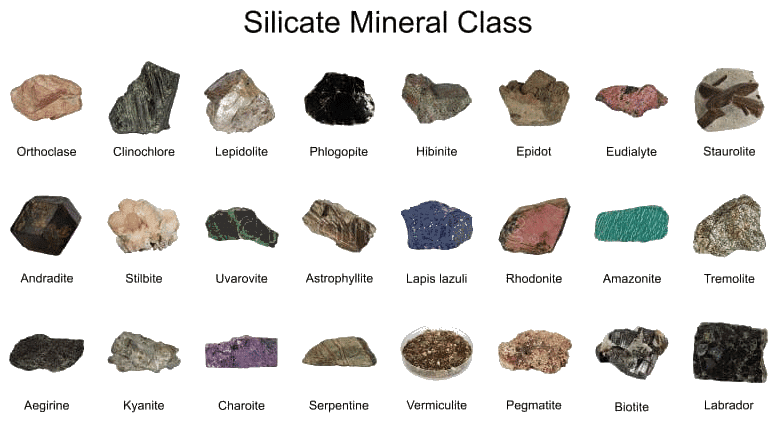
Minerals are substances that occur naturally and have a consistent chemical composition. They can be categorized into two main types: metallic and non-metallic minerals, based on their chemical and physical properties.
Differences between Metallic and Non-Metallic Minerals
Metallic Minerals:
- Metallic minerals contain metals in their raw form.
- These metals are typically found in association with igneous rocks.
- Metallic minerals are usually hard and have a natural shine.
- Examples include iron, copper, bauxite, and tin.
Non-Metallic Minerals:
- Non-metallic minerals do not contain metals.
- These minerals are generally associated with sedimentary rocks.
- Non-metallic minerals are not usually hard and do not have a natural shine.
- Examples include salt, coal, mica, and clay.
Characteristics of Minerals
- Distribution: Minerals are not evenly distributed across the Earth's surface.
- Exhaustibility: Minerals are exhaustible resources because they cannot be replenished immediately. Therefore, it is important to conserve them.
- Uniformity: Not all minerals have uniform properties. They differ in their chemical compositions, which affects their characteristics.
- Variability: Minerals vary in color, lustre (shine), and texture. These differences are important for identifying and classifying minerals.
Minerals in India
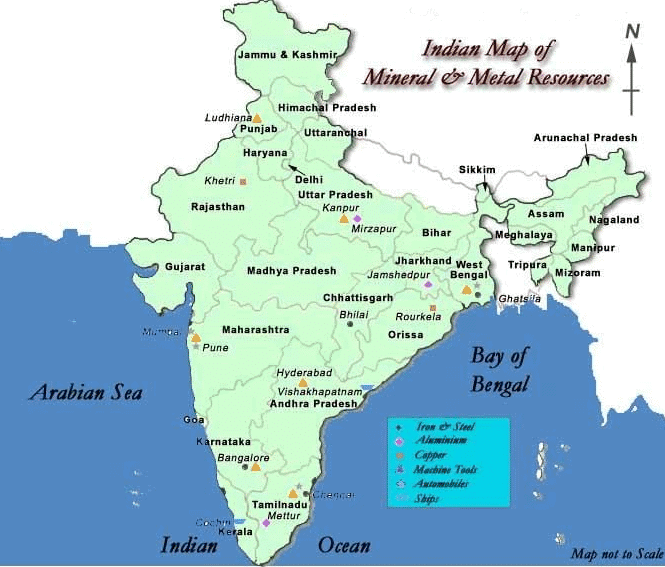
India is endowed with a wide variety of minerals due to its diverse geological makeup. Some of the most commonly found minerals in India include coal, bauxite, mica, iron ore, and manganese.
Coal
- Coal is found in sedimentary rocks and was formed from the remains of plants and ferns that were buried in ancient swamp forests. Over time, the heat and pressure from the layers of soil and rock above these decayed plants caused physical and chemical changes, resulting in coal.
- The composition of coal includes carbon, hydrogen, oxygen, nitrogen, and small amounts of phosphorus and sulfur.
- Coal can be classified into four main types based on its carbon content, moisture, and volatile matter: anthracite, bituminous, lignite, and peat.
Anthracite
- Anthracite is the hardest and highest quality type of coal, with a carbon content of over 90%.
- It burns slowly and produces little smoke, making it a cleaner burning fuel.
- Anthracite also leaves behind very little ash and has a high heating value, making it an efficient source of energy.
Bituminous
- Bituminous coal has a carbon content that varies from 50% to 80%.
- It is hard and black in appearance, and it makes up about 80% of the total coal output worldwide.
- This type of coal is commonly used for household purposes and is also widely used in various industries.
- High-grade bituminous coal is particularly valuable in blast furnaces for smelting iron.
Lignite
- Lignite, also known as brown coal, is a low-grade coal that is softer and has a higher moisture content compared to other types of coal.
Peat
- Peat is the least developed form of coal, with the lowest carbon content.
- It is considered inferior to the other three varieties of coal and represents the initial stage in the transformation of wood into coal.
Applications of Coal
- Electricity Generation: Coal is a primary fuel source in thermal power plants for producing electricity.
- Domestic Use: Coal is utilized for heating and energy purposes in households.
- Industrial Manufacturing: Coal is essential in the production of iron and steel and serves as a raw material in various industries.
- By-Products: During the production of metallurgical coke by burning coal in a closed chamber, by-products like ammonia and benzol are obtained from the released gases.
Distribution of Coal in India
- Coal in India is primarily found in two types of fields: Gondwana coalfields and Tertiary coalfields. The predominant type of coal found is Bituminous coal.
Gondwana Coalfields
Overview: Gondwana coalfields constitute 98% of India’s coal reserves and are characterized by low moisture content.
Locations: These coal deposits are located in the river valleys of the Damodar, Mahanadi, and Godavari rivers.
States: Gondwana coal deposits are found in the following states:
- West Bengal
- Jharkhand
- Odisha
- Chhattisgarh
- Madhya Pradesh
- Uttar Pradesh
- Andhra Pradesh
Tertiary Coalfields
Characteristics: The coal found in Tertiary coalfields has a high moisture content.
Locations:These coalfields are primarily located in the northeastern states of India, including:
- Assam
- Arunachal Pradesh
- Meghalaya
- Nagaland
Petroleum

Petroleum is a natural mixture of hydrocarbon compounds found deep underground in sedimentary rock formations like sandstone, shale, and limestone. During the refining process, various products are extracted from petroleum, including petrol, diesel, tar, kerosene, LPG (liquefied petroleum gas), and paraffin wax.
Uses of Petroleum
- Fuel for Transport: Petroleum is a crucial fuel source for land, sea, and air transport.
- Production of Petrochemicals: After refining, petroleum is used to produce various petrochemicals such as gasoline, lubricating oil, and printing ink.
- Power Generation: Petroleum is also used for generating power.
Major Oil Reserves and Fields in India
- Mumbai High: An offshore oil field located about 176 km off the coast of Mumbai in the Arabian Sea.
- Digboi Oil Field: Situated in Assam, this is the largest oil field in India.
- Khambhat Basin: Located in Gujarat, this is a significant oil-producing area. Other important oil fields in Gujarat include Kalol, Koyali, Kosamba, Sanand, Kathana, Ankleshwar, and Navgaon.
Oil Refineries in India
- There are 21 oil refineries across India.
- Reliance Petroleum Limited: The first private sector oil refinery in India, located in Jamnagar, Gujarat.
- Digboi Oil Refinery: The oldest oil refinery in India, located in Digboi, Assam.
Iron Ore
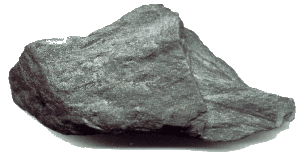
Varieties of Iron Ore
Hematite
- Known as ‘red ore’.
- Contains 60–70% of pure iron.
- Found in Odisha, Jharkhand, Chhattisgarh, Karnataka, and Maharashtra.
Magnetite
- Known as ‘black ore’.
- Contains more than 70% of iron, making it the best quality iron ore.
- Possesses magnetic properties, hence the name magnetite.
- Found in Tamil Nadu and Karnataka.
Limonite
- Inferior quality iron ore containing 35–50% of iron.
- Yellow-brown in color.
- Found in Garhwal (Uttarakhand), Mirzapur district (Uttar Pradesh), and Kangra Valley (Himachal Pradesh).
Main Iron Ore Deposits in India
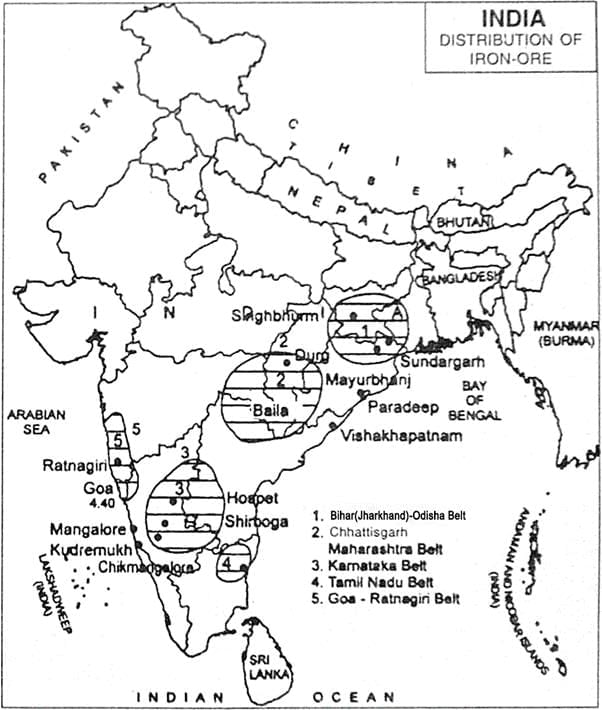
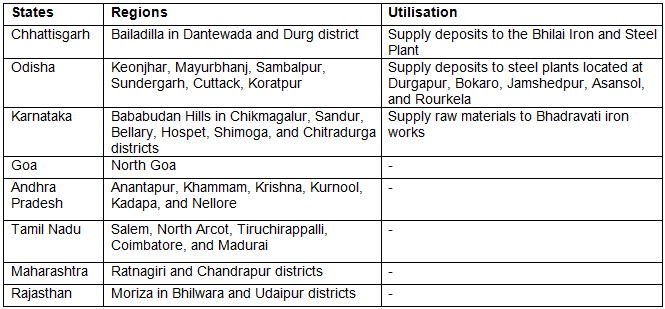
Manganese
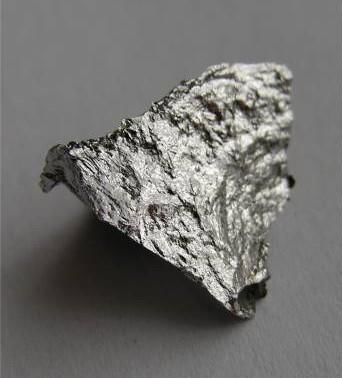
Manganese is a black, hard metal primarily used as a raw material for smelting iron ore and for manufacturing ferro alloys.
Uses of Manganese
- Iron and Steel Industry: Manganese is essential for hardening steel and preventing rust.
- Batteries: Used in dry cell batteries.
- Alloys: Used in the production of various alloys.
- Chemical, Glass, and Electrical Industries: Utilized in various applications within these industries.
Major Deposits in India:
- Andhra Pradesh: Adilabad, Vishakhapatnam, and Vizianagaram.
- Goa: Sanguem.
- Jharkhand: Singhbhum, Palamau, and Chaibasa.
- Karnataka: Sandur, Shimoga, Chitradurga, Bellary, North Kanara, Tumkur, Belgaum, and Davangere.
- Madhya Pradesh: Chhindwara, Balaghat, Mandla, and Jabalpur; also in Nagpur and Bhandara.
- Odisha: Keonjhar, Mayurbhanj, Talcher, Sundargarh, Bonai, and Koratpur.
- Rajasthan: Banswara, Udaipur, and Pali.
Bauxite
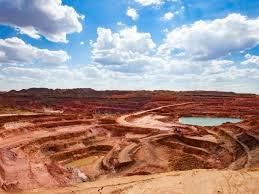
Bauxite is a type of aluminium oxide ore.
Uses of Bauxite
- Bauxite is the primary source of aluminium, a metal known for being lightweight, strong, and resistant to rust.
- Aluminium extracted from bauxite is used in various industries including:
- Aircraft and Automotive: Due to its strength and lightweight properties, aluminium is widely used in the manufacturing of aircraft and automobiles.
- Shipping Industry: Aluminium’s resistance to corrosion makes it ideal for use in ships and other marine applications.
- Household Appliances: Many household appliances are made using aluminium for its durability and rust resistance.
- Electrical Industry: Aluminium is also a good conductor of electricity, which makes it useful in the electrical industry for wiring and other applications.
Main Deposits of Bauxite in India
- Goa: Districts of Mopa and Pernem.
- Odisha: Districts of Kalahandi and Sambalpur.
- Gujarat: Various districts including Jamnagar, Kaira, Surat, and Kachchh.
- Madhya Pradesh: Districts of Jabalpur, Balaghat, Shahdol, Mandla, and the Amarkantak Plateau.
- Chhattisgarh: Districts of Durg, Bilaspur, and Raigarh.
- Jharkhand: Districts of Palamau and Ranchi.
- Maharashtra: Districts of Thane, Kolhapur, Ratnagiri, and Satara.
- Karnataka: District of Belgaum, mainly at Karle Hills.
- Tamil Nadu: Districts of Salem, Nilgiri, Madurai, and Coimbatore.
Largest Integrated Aluminium Plant
- The largest integrated aluminium plant in India is located at Renukoot in Uttar Pradesh.
- This plant sources its bauxite supply from the Amarkantak Plateau in Madhya Pradesh and from Ranchi in Jharkhand.
Limestone
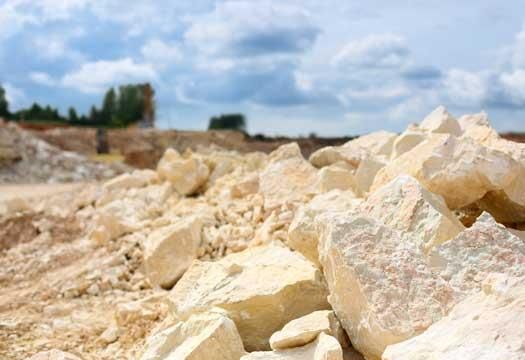
Limestone is a non-metallic mineral that forms through the deposition and hardening of skeletons, remains of animals, and shells. It is found in nearly every state of India.
Uses of Limestone
- Iron and Steel Industry: Limestone is used as a flux in the production of iron and steel.
- Cement Industry: The primary use of limestone is in the cement industry.
- Quicklime and Slaked Lime: Limestone is used in the manufacturing of quicklime and slaked lime.
- Underground Coal Mines: Limestone is used to suppress methane explosions in underground coal mines.
- Chemical Production: Limestone is used in the production of various chemicals, as well as in the manufacturing of paper, glass, and fertilizers.
|
29 docs|1 tests
|
FAQs on Revision Notes: Minerals in India - Environmental Management for Grade 9
| 1. What are the main characteristics of minerals found in India? |  |
| 2. Where is coal primarily distributed in India? |  |
| 3. What are the significant uses of petroleum in India? |  |
| 4. How is iron ore distributed across India? |  |
| 5. What is the importance of bauxite mining in India? |  |





















